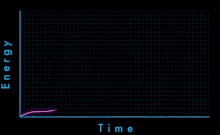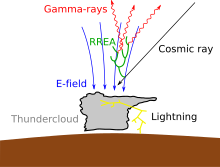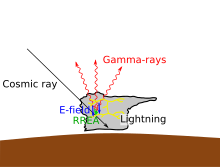
A terrestrial gamma-ray flash (TGF), also known as dark lightning, is a burst of gamma rays produced in Earth's atmosphere. TGFs have been recorded to last 0.2 to 3.5 milliseconds, and have energies of up to 20 million electronvolts. It is speculated that TGFs are caused by intense electric fields produced above or inside thunderstorms. Scientists have also detected energetic positrons and electrons produced by terrestrial gamma-ray flashes.
Discovery

Terrestrial gamma-ray flashes were first discovered in 1994 by BATSE, or Burst and Transient Source Experiment, on the Compton Gamma Ray Observatory, a NASA spacecraft. A subsequent study from Stanford University in 1996 linked a TGF to an individual lightning strike occurring within a few milliseconds of the TGF. BATSE detected only a small number of TGF events in nine years (76), due to it having been constructed to study gamma ray bursts from outer space, which last much longer.
In the early 2000s, the Ramaty High Energy Solar Spectroscopic Imager (RHESSI) satellite observed TGFs with much higher energies than those recorded by BATSE. The RHESSI data led scientists to estimate that approximately 50 TGFs occur each day, more than previously thought but still only representing a very small fraction of the total lightning on Earth (3–4 million lightning events per day on average). A few years later, scientists using NASA's Fermi Gamma-ray Space Telescope, which was designed to monitor gamma rays, estimated that about 500 TGFs occur daily worldwide, but most go undetected.
Mechanism

Though the details of the mechanism are uncertain, there is a consensus forming about the physical requirements. It is presumed that TGF photons are emitted by electrons traveling at speeds very close to the speed of light that collide with the nuclei of atoms in the air and release their energy in the form of gamma rays (bremsstrahlung). Large populations of energetic electrons can form by avalanche growth driven by electric fields, a phenomenon called relativistic runaway electron avalanche (RREA). The electric field is likely provided by lightning, as most TGFs have been shown to occur within a few milliseconds of a lightning event (Inan et al. 1996). Beyond this basic picture the details are uncertain. Recent research has shown that electron-electron (Bremsstrahlung) leads first to an enrichment of high-energy electrons and subsequently enlarges the number of high-energy photons.
Some of standard theoretical frameworks have been borrowed from other lightning-associated discharges like sprites, blue jets, and elves, which were discovered in the years immediately preceding the first TGF observations. For instance, that field may be due to the separation of charges in a thundercloud ("DC" field) often associated with sprites, or due to the electromagnetic pulse (EMP) produced by a lightning discharge, often associated with elves. There is also some evidence that certain TGFs occur in the absence of lightning strikes, though in the vicinity of general lightning activity, which has evoked comparisons to blue jets.

The DC field model requires a very large thundercloud charge to create sufficient fields at high altitudes (e.g. 50–90 km, where sprites form). Unlike the case of sprites, these large charges do not seem to be associated with TGF-generating lightning. Thus the DC field model requires the TGF to occur lower down, at the top of the thundercloud (10–20 km) where a local field can be stronger. This hypothesis is supported by two independent observations. First, the spectrum of the gamma-rays seen by RHESSI matches very well to the prediction of relativistic runaway at 15–20 km. Second, TGFs are strongly concentrated around Earth's equator when compared to lightning. (They may also be concentrated over water compared to lightning in general.) Thundercloud tops are higher near the equator, and thus the gamma-rays from TGFs produced there have a better chance of escaping the atmosphere. The implication would then be that there are many lower-altitude TGFs not seen from space, particularly at higher latitudes.

An alternative hypothesis, the EMP model, relaxes the requirement on thundercloud charge but instead requires a large current pulse moving at very high speed. The required current pulse speed is very restrictive, and there is not yet any direct observational support for this model.
Another hypothetical mechanism is that TGFs are produced within the thundercloud itself, either in the strong electric fields near the lightning channel or in the static fields that exist over large volumes of the cloud. These mechanisms rely on extreme activity of the lightning channel to start the process (Carlson et al. 2010) or on strong feedback to allow even small-scale random events to trigger production. The Atmosphere-Space Interactions Monitor (ASIM), dedicated to measuring simultaneously optical signals of lightning and signals of terrestrial gamma-ray flashes, revealed that TGFs are usually associated with optical flashes, strongly suggesting that relativistic electrons as precursors of TGFs are produced in the strong electric fields in the proximity of lightning channels.
Conjugate events

It has been suggested that TGFs must also launch beams of highly relativistic electrons and positrons which escape the atmosphere, propagate along Earth's magnetic field and precipitate on the opposite hemisphere. A few cases of TGFs on RHESSI, BATSE, and Fermi-GBM have shown unusual patterns that can be explained by such electron/positron beams, but such events are very unusual.
Calculations have shown that TGFs can liberate not only positrons, but also neutrons and protons. Neutrons have already been measured in electric discharges, whereas there is no experimental confirmation of discharge related protons (2016). Recent research has shown that the fluence of these neutrons lies between 10 and 10 per ms and per m depending on the detection altitude. The energy of most of these neutrons, even with initial energies of 20 MeV, decreases down to the keV range within 1 ms.
Other research
Terrestrial gamma-ray flashes pose a challenge to current theories of lightning, especially with the discovery of the clear signatures of antimatter produced in lightning.
It has been discovered in the past 15 years that among the processes of lightning is some mechanism capable of generating gamma rays, which escape the atmosphere and are observed by orbiting spacecraft. Brought to light by NASA's Gerald Fishman in 1994 in an article in Science, these so-called terrestrial gamma-ray flashes (TGFs) were observed by accident, while he was documenting instances of extraterrestrial gamma ray bursts observed by the Compton Gamma Ray Observatory (CGRO). TGFs are much shorter in duration, however, lasting only about 1 ms.
Professor Umran Inan of Stanford University linked a TGF to an individual lightning stroke occurring within 1.5 ms of the TGF event, proving for the first time that the TGF was of atmospheric origin and associated with lightning strikes.
CGRO recorded only about 77 events in 10 years; however, more recently the Reuven Ramaty High Energy Solar Spectroscopic Imager (RHESSI) spacecraft, as reported by David Smith of UC Santa Cruz, has been observing TGFs at a much higher rate, indicating that these occur about 50 times per day globally (still a very small fraction of the total lightning on the planet). The energy levels recorded exceed 20 MeV.
Scientists from Duke University have also been studying the link between certain lightning events and the mysterious gamma ray emissions that emanate from the Earth's own atmosphere, in light of newer observations of TGFs made by RHESSI. Their study suggests that this gamma radiation fountains upward from starting points at surprisingly low altitudes in thunderclouds.
Steven Cummer, from Duke University's Pratt School of Engineering, said, "These are higher energy gamma rays than those coming from the Sun. And yet here they are coming from the kind of terrestrial thunderstorm that we see here all the time."
Early hypotheses of this pointed to lightning generating high electric fields and driving relativistic runaway electron avalanche at altitudes well above the cloud where the thin atmosphere allows gamma rays to easily escape into space, similar to the way sprites are generated. Subsequent evidence however, has suggested instead that TGFs may be produced by driving relativistic electron avalanches within or just above high thunderclouds. Though hindered by atmospheric absorption of the escaping gamma rays, these theories do not require the exceptionally intense lightning that high altitude theories of TGF generation rely on.
The role of TGFs and their relationship to lightning remains a subject of ongoing scientific study.
In 2009, the Fermi Gamma-ray Space Telescope in Earth orbit observed intense burst of gamma rays corresponding to positron annihilations coming out of a storm formation. Scientists would not have been surprised to see a few positrons accompanying any intense gamma ray burst, but the lightning flash detected by Fermi appeared to have produced about 100 trillion positrons. This was reported by news media in January 2011, and had never been previously observed.
The Atmosphere-Space Interactions Monitor (ASIM), an experiment dedicated to study TGFs, was launched to the International Space Station on 2 April 2018 and was mounted on the Columbus External Payload Facility on 13 April 2018.
See also
References
- Palmer, Jason (11 January 2011). "Antimatter Caught Streaming from Thunderstorms on Earth". BBC News. Retrieved 17 January 2016.
- ^ Perrotto, Trent; Anderson, Janet (10 January 2011). "NASA's Fermi Catches Thunderstorms Hurling Antimatter Into Space" (Press release). NASA. Archived from the original on 21 January 2019. Retrieved 17 January 2016.
- ^ Fishman, G. J.; Bhat, P. N.; Mallozzi, R.; Horack, J. M.; Koshut, T.; Kouveliotou, C.; Pendleton, G. N.; Meegan, C. A.; Wilson, R. B.; Paciesas, W. S.; Goodman, S. J.; Christian, H. J. (May 27, 1994). "Discovery of Intense Gamma-Ray Flashes of Atmospheric Origin" (PDF). Science. 264 (5163): 1313–1316. Bibcode:1994STIN...9611316F. doi:10.1126/science.264.5163.1313. hdl:2060/19960001309. PMID 17780850. S2CID 20848006. Archived from the original (PDF) on March 10, 2012. Retrieved August 28, 2015.
- Smith, D. M.; Lopez, L. I.; Lin, R. P.; Barrington-Leigh, C. P. (2005). "Terrestrial Gamma-Ray Flashes Observed up to 20 MeV" (PDF). Science. 307 (5712): 1085–1088. Bibcode:2005Sci...307.1085S. doi:10.1126/science.1107466. PMID 15718466. S2CID 33354621. Archived from the original (PDF) on 2017-08-09. Retrieved 2015-08-28.
- Administrator, NASA (2013-06-07). "Flashes in the Sky: Earth's Gamma-Ray Bursts Triggered by Lightning". NASA. Archived from the original on 2016-06-03. Retrieved 2018-05-23.
- Garner, Rob (2015-06-26). "Fermi Catches Antimatter-Hurling Storms". NASA. Retrieved 2018-05-23.
- Koehn, C., Ebert, U., Angular distribution of Bremsstrahlung photons and of positrons for calculations of terrestrial gamma-ray flashes and positron beams, Atmos. Res. (2014), vol. 135-136, pp. 432-465
- Gurevich, A. V.; Milikh, G. M.; Roussel-Dupre, R. (June 1992). "Runaway electron mechanism of air breakdown and preconditioning during a thunderstorm" (PDF). Physics Letters A. 165 (5–6): 463. Bibcode:1992PhLA..165..463G. doi:10.1016/0375-9601(92)90348-P. Archived from the original (PDF) on 2013-02-17. Retrieved 2015-08-28.
- Dwyer, J. R. (2003). "A fundamental limit on electric fields in air". Geophysical Research Letters. 30 (20): 2055. Bibcode:2003GeoRL..30.2055D. doi:10.1029/2003GL017781.
- ^ Cummer, S. A.; Zhai, Y.; Hu, W.; Smith, D. M.; Lopez, L. I.; Stanley, M. A. (2005). "Measurements and implications of the relationship between lightning and terrestrial gamma ray flashes". Geophysical Research Letters. 32 (8): L08811. Bibcode:2005GeoRL..32.8811C. doi:10.1029/2005GL022778. S2CID 14055893.
- Inan, U. S.; Cohen, M. B.; Said, R. K.; Smith, D. M.; Lopez, L. I. (2006). "Terrestrial gamma ray flashes and lightning discharges". Geophysical Research Letters. 33 (18): L18802. Bibcode:2006GeoRL..3318802I. doi:10.1029/2006GL027085.
- Cohen, M. B.; Inan, U. S.; Fishman, G. (2006). "Terrestrial gamma ray flashes observed aboard the Compton Gamma Ray Observatory/Burst and Transient Source Experiment and ELF/VLF radio atmospherics". Journal of Geophysical Research. 111 (D24): D24109. Bibcode:2006JGRD..11124109C. doi:10.1029/2005JD006987.
- C. Koehn and U. Ebert The importance of electron-electron Bremsstrahlung for terrestrial gamma-ray flashes, electron beams and electron-positron beams J. Phys. D.: Appl. Phys. as Fast Track Communication (2014), vol. 47, 252001
- Dwyer, J. R.; Smith, D. M. (2005). "A comparison between Monte Carlo simulations of runaway breakdown and terrestrial gamma-ray flash observations" (PDF). Geophysical Research Letters. 32 (22): L22804. Bibcode:2005GeoRL..3222804D. doi:10.1029/2005GL023848.
- Williams, E.; Boldi, R.; Bór, J.; Sátori, G.; Price, C.; Greenberg, E.; Takahashi, Y.; Yamamoto, K.; Matsudo, Y.; Hobara, Y.; Hayakawa, M.; Chronis, T.; Anagnostou, E.; Smith, D. M.; Lopez, L. I. (2006). "Lightning flashes conducive to the production and escape of gamma radiation to space". Journal of Geophysical Research. 111 (D16): D16209. Bibcode:2006JGRD..11116209W. doi:10.1029/2005JD006447.
- Inan, U. S.; Lehtinen, N. G. (2005). "Production of terrestrial gamma-ray flashes by an electromagnetic pulse from a lightning return stroke". Geophysical Research Letters. 32 (19): L19818. Bibcode:2005GeoRL..3219818I. doi:10.1029/2005GL023702.
- Dwyer, J. R. (2008). "Source mechanisms of terrestrial gamma-ray flashes". Journal of Geophysical Research. 113 (D10): D10103. Bibcode:2008JGRD..11310103D. doi:10.1029/2007JD009248.
- Köhn, C.; Heumesser, M.; Chanrion, O.; Nishikawa, K.; Reglero, V.; Neubert, T. (2020). "The Emission of Terrestrial Gamma Ray Flashes From Encountering Streamer Coronae Associated to the Breakdown of Lightning Leaders". Geophysical Research Letters. 47 (20): e89749. Bibcode:2020GeoRL..4789749K. doi:10.1029/2020GL089749.
- Heumesser, M.; et al. (2020). "Spectral Observations of Optical Lightning Activity Associated with Terrestrial Gamma-Ray Flashes". Geophysical Research Letters. doi:10.1002/essoar.10504237.1. hdl:10261/240037.
- Dwyer, J. R.; Grefenstette, B. W.; Smith, D. M. (2008). "High-energy electron beams launched into space by thunderstorms". Geophysical Research Letters. 35 (2): L02815. Bibcode:2008GeoRL..35.2815D. doi:10.1029/2007GL032430.
- Briggs, M. S.; Connaughton, V.; Wilson-Hodge, C.; Preece, R. D.; Fishman, G. J.; Kippen, R. M.; Bhat, P. N.; Paciesas, R. M.; Chaplin, V. L.; Meegan, C. A.; Von Kienlin, A.; Greiner, J.; Dwyer, J. R.; Smith, D. M. (2011). "Electron-positron beams from terrestrial lightning observed with Fermi GBM". Geophysical Research Letters. 38 (2): n/a. Bibcode:2011GeoRL..38.2808B. doi:10.1029/2010GL046259. S2CID 56402672.
- Köhn, C.; Ebert, U. (2015). "Calculation of beams of positrons, neutrons and protons associated with terrestrial gamma-ray flashes". J. Geophys. Res. Atmos. 120 (4): 1620–1635. Bibcode:2015JGRD..120.1620K. doi:10.1002/2014JD022229.
- ^ Köhn, C.; Diniz, G.; Harakeh, Muhsin (2017). "Production mechanisms of leptons, photons, and hadrons and their possible feedback close to lightning leaders". J. Geophys. Res. Atmos. 122 (2): 1365–1383. Bibcode:2017JGRD..122.1365K. doi:10.1002/2016JD025445. PMC 5349290. PMID 28357174.
- Agafonov, A. V.; Bagulya, A. V.; Dalkarov, O. D.; Negodaev, M. A.; Oginov, A. V.; Rusetskiy, A. S.; Ryabov, V. A.; Shpakov, K. V. (2013). "Observation of neutron bursts produced by laboratory high-voltage atmospheric discharge". Phys. Rev. Lett. 111 (11): 115003. arXiv:1304.2521. Bibcode:2013PhRvL.111k5003A. doi:10.1103/physrevlett.111.115003. PMID 24074098. S2CID 139192.
- Cowen, Ron (November 6, 2009). "Signature Of Antimatter Detected In Lightning". Science News. Archived from the original on 2009-11-10. Retrieved 2012-06-23.
- U.S. Inan; S.C. Reising; G.J. Fishman & J.M. Horack (1996). "On the association of terrestrial gamma-ray bursts with lightning and implications for sprites" (PDF). Geophysical Research Letters. 23 (9): 1017. Bibcode:1996GeoRL..23.1017I. doi:10.1029/96GL00746. hdl:10217/68065.. As quoted by elf.gi.alaska.edu Retrieved 2007-03-06.
- "Gamma Rays From Thunderstorms?". Duke Today. 2 May 2005. Retrieved 17 December 2023. (Duke Today Staff)
- Thunderstorms Shoot Antimatter Beams Into Space. News.nationalgeographic.com (2011-01-11). Retrieved on 2012-06-23.
- Briggs, Michael S.; Connaughton, Valerie; Wilson-Hodge, Colleen; Preece, Robert D.; Fishman, Gerald J.; Kippen, R. Marc; Bhat, P. N.; Paciesas, William S.; Chaplin, Vandiver L.; Meegan, Charles A.; von Kienlin, Andreas; Greiner, Jochen; Dwyer, Joseph R.; Smith, David M. (2011). "Electron-positron beams from terrestrial lightning observed with Fermi GBM". Geophysical Research Letters. 38 (2). Bibcode:2011GeoRL..38.2808B. doi:10.1029/2010GL046259. S2CID 56402672.
- Mary Halton (6 April 2018). "Hunting mystery giant lightning from space". BBC News. Retrieved 17 December 2023.
Further reading
- Barrington-Leigh, Christopher P. "Terrestrial Gamma-ray Flashes after CGRO: prospects for HESSI" (PDF). University of California Berkeley, Space Physics Research Group. Retrieved April 2, 2005.
- Dwyer, Joseph R.; Smith, David M.; Uman, Martin A.; Saleh, Ziad; Grefenstette, Brian W.; Hazelton, Bryna J. C.; Rassoul, Hamid K. (2010). "Estimation of the fluence of high-energy electron bursts produced by thunderclouds and the resulting radiation doses received in aircraft". Journal of Geophysical Research. 115. Bibcode:2010JGRD..115.9206D. doi:10.1029/2009JD012039.
- McKee, Maggie (February 17, 2005). "Earth creates powerful gamma-ray flashes". New Scientist.
- Stephens, Tim (February 21, 2005). "New satellite observations of terrestrial gamma-ray flashes reveal surprising features of mysterious blasts from Earth". Currents Online.